Subregion-Scale Geothermal Delineation Based on Image Analysis Using Reflection Seismology and Well Data with an Outlook for Land Use
Abstract
1. Introduction
2. Materials and Methods
2.1. Geological Background
2.2. Data Management and Analysis
2.3. GIS Calculations to Delineate Geothermal Subregions and to Provide Land Cover Type Characterisation
3. Results
3.1. Interpretation of Seismic Sections
3.2. Interpretation of Temperature and Depth Maps
3.3. Geothermal Subregions of the Study Area
3.3.1. GSR1
3.3.2. GSR2
3.3.3. GSR3
3.3.4. GSR4
3.3.5. GSR5
3.3.6. GSR6
3.3.7. GSR7
3.3.8. GSR8
3.3.9. GSR9
4. Discussion
5. Conclusions
Author Contributions
Funding
Institutional Review Board Statement
Informed Consent Statement
Conflicts of Interest
References
- Rybach, L. Geothermal sustainability. In Proceedings of the European Geothermal Congress, Unterhaching, Germany, 30 May–1 June 2007; pp. 1–5. [Google Scholar]
- Stober, I.; Bucher, K. Geothermal Energy. From Theoretical Models to Exploration and Development, 2nd ed.; Springer Nature: Cham, Switzerland, 2021; 390p. [Google Scholar]
- Axelsson, G. Sustainable geothermal utilization–Case histories; definitions; research issues and modelling. Geothermics 2010, 39, 283–291. [Google Scholar] [CrossRef]
- Szanyi, J.; Kovács, B. Utilization of geothermal systems in South-East Hungary. Geothermics 2010, 39, 357–364. [Google Scholar] [CrossRef]
- Rubio-Maya, C.; Ambríz Díaz, V.M.; Pastor Martínez, E.; Belman-Flores, J.M. Cascade utilization of low and medium enthalpy geothermal resources–A review. Renew. Sustain. Energy Rev. 2015, 52, 689–716. [Google Scholar] [CrossRef]
- Fabbri, P.; Pola, M.; Piccinini, L.; Zampieri, D.; Roghel, A.; Dalla Libera, N. Monitoring, utilization and sustainable development of a low-temperature geothermal resource: A case study of the Euganean Geothermal Field (NE, Italy). Geothermics 2017, 70, 281–294. [Google Scholar] [CrossRef]
- Buday, T.; Szűcs, P.; Kozák, M.; Püspöki, Z.; McIntosh, R.W.; Bódi, E.; Bálint, B.; Bulátkó, K. Sustainability aspects of thermal water production in the region of Hajdúszoboszló-Debrecen, Hungary. Environ. Earth Sci. 2015, 74, 7511–7521. [Google Scholar] [CrossRef]
- Halaj, E. Characteristics and sustainable utilisation prospects of geothermal waters of the liassic formations in the Mogilno–Lodz Trough, Poland. Sustain. Water Resour. Manag. 2019, 5, 1537–1553. [Google Scholar] [CrossRef]
- Boguniewicz-Zabłocka, J.; Łukasiewicz, E.; Guida, D. Analysis of the Sustainable Use of Geothermal Waters and Future Development Possibilities—A Case Study from the Opole Region, Poland. Sustainability 2019, 11, 6730. [Google Scholar] [CrossRef]
- Szűcs, P.; Szabó, N.P.; Zubair, M.; Szalai, S. Innovative Hydrogeophysical Approaches as Aids to Assess Hungarian Groundwater Bodies. Appl. Sci. 2021, 11, 2099. [Google Scholar] [CrossRef]
- Kana, J.D.; Djongyang, N.; Raïdandi, D.; Njandjock Nouck, P.; Dadjé, A. A review of geophysical methods for geothermal exploration. Renew. Sustain. Energy Rev. 2015, 44, 87–95. [Google Scholar] [CrossRef]
- Vakarcs, G. Sequence Stratigraphy of the Cenozoic Pannonian Basins. Ph.D. Thesis, Rice University, Houston, TX, USA, 1997. [Google Scholar]
- Pogácsás, G.; Lakatos, L.; Újszászi, K.; Vakarcs, G.; Várkonyi, L.; Várnai, P.; Révész, I. Seismic facies, electro facies and Neogene sequence chronology of the Pannonian Basin. Acta Geol. Hung. 1988, 31, 175–207. [Google Scholar]
- Juhász, G. A pannóniai (s.l.) formációk térképezése az Alföldön: Elterjedés, fácies és üledékes környezet. Pannonian (s.l.) lithostratigraphic units in the Great Hungarian Plain: Distribution, facies and sedimentary environment. Földtani Közlöny 1992, 122, 133–165. [Google Scholar]
- Juhász, G.; Magyar, I. A pannóniai (s.l.) litofáciesek és molluszka-biofáciesek jellemzése és korrelációja az Alföldön. Review and correlation of the Late Neogene (Panonian s.l. lithofacies and mollusc biofacies in the great Hungarian Plain. Földtani Közlöny 1992, 122, 167–194. [Google Scholar]
- Lenkey, L.; Zsemle, F.; Mádl-Szőnyi, J.; Dövényi, P.; Rybach, L. Possibilities and limitations in the utilization of the Neogene geothermal reservoirs in the Great Hungarian Plain, Hungary. Cent. Eur. Geol. 2008, 51, 241–252. [Google Scholar] [CrossRef]
- Szanyi, J.; Kovács, B.; Scharek, P. Geothermal Energy in Hungary: Potentials and barriers. Eur. Geol. 2009, 27, 15–19. [Google Scholar]
- Horváth, F.; Musitz, B.; Balázs, A.; Végh, A.; Uhrin, A.; Nádor, A.; Koroknai, B.; Pap, N.; Tóth, T.; Wórum, G. Evolution of the Pannonian basin and its geothermal resources. Geothermics 2015, 53, 328–352. [Google Scholar] [CrossRef]
- Tóth, A.N. Country Update for Hungary. In Proceedings of the World Geothermal Congress 2020+1, Reykjavik, Iceland, 21–26 May 2021; pp. 1–10. [Google Scholar]
- Magyar, I. A Pannon-Medence Ősföldrajza és Környezeti Viszonyai a Késő Miocénben; Geolitera, SZTE TTIK Földrajzi és Földtani Tanszékcsoport: Szeged, Hungary, 2010; 140p. [Google Scholar]
- Dövényi, P.; Horváth, F. A review of temperature, thermal conductivity, and heat flow data for the pannonian basin. In The Pannonian Basin; A Study in Basin Evolution; Royden, L.H., Horváth, F., Eds.; American Association of Petroleum Geologists Memoir: Tulsa, OK, USA, 1988; Volume 45, pp. 195–233. [Google Scholar]
- Rezessy, G.; Szanyi, J.; Hámor, T. Report on Development of Geothermal Energy Inventory; Hungarian Geological Survey: Budapest, Hungary, 2005; 82p. (In Hungarian) [Google Scholar]
- Zilahi-Sebess, L.; Merényi, L.; Gulyás, Á.; Paszera, G.; Tóth, G.; Boda, E.; Budai, T. Nemzeti Energiastratégia, Készlet gazdálkodási és hasznosítási cselekvési terv. In Nyersanyag Készletek, A Hazai Ásványi Nyersanyag-Potenciál, 5. Geotermikus Energia; Manuscript; Magyar Földtani és Geofizikai Intézet: Budapest, Hungary, 2012; 84p. [Google Scholar]
- Békési, E.; Lenkey, L.; Limberger, J.; Porkoláb, K.; Balázs, A.; Bonté, D.; Vrijlandt, M.; Horváth, F.; Cloetingh, S.; van Wees, J.-D. Subsurface temperature model of the Hungarian part of the Pannonian Basin. Glob. Planet. Change 2018, 171, 48–64. [Google Scholar] [CrossRef]
- Juhász, G.; Pogácsás, G.; Magyar, I.; Vakarcs, G. Integrált-sztratigráfiai és fejlődéstörténeti vizsgálatok az Alföld pannóniai s.l. rétegsorában (Integrated stratigraphy and sedimentary evolution of the Late Neogene sediments of the Hungarian Plain, Pannonian Basin). Földtani Közlöny 2006, 136, 51–86. [Google Scholar]
- Mattick, R.E.; Phillips, R.L.; Rumpler, J. Seismic stratigraphy and depositional framework of sedimentary rocks in the Pannonian Basin in southeasterns Hungary. In The Pannonian Basin; A Study in Basin Evolution; Royden, L.H., Horváth, F., Eds.; American Association of Petroleum Geologists Memoir: Tulsa, OK, USA, 1988; Volume 45, pp. 117–145. [Google Scholar]
- Tóth, J.; Almási, I. Interpretation of observed fluid potential patterns in a deep sedimentary basin under tectonic compression: Hungarian Great Plain, Pannonian Basin. Geofluids 2001, 1, 11–36. [Google Scholar] [CrossRef]
- Csató, I.; Tóth, S.; Catuneanu, O.; Granjeon, D. A sequence stratigraphic model for the Upper Miocene–Pliocene basin fill of the Pannonian Basin, eastern Hungary. Mar. Pet. Geol. 2015, 66, 117–134. [Google Scholar] [CrossRef]
- Balázs, A.; Matenco, L.; Magyar, I.; Horváth, F.; Cloetingh, S. The link between tectonics and sedimentation in back-arc basins: New genetic constraints from the analysis of the Pannonian Basin. Tectonics 2016, 35, 1526–1559. [Google Scholar] [CrossRef]
- Willems, C.J.L.; Cheng, C.; Watson, S.M.; Minto, J.; Williams, A.; Walls, D.; Milsch, H.; Burnside, N.M.; Westaway, R. Permeability and Mineralogy of the Újfalu Formation, Hungary, from Production Tests and Experimental Rock Characterization: Implications for Geothermal Heat Projects. Energies 2021, 14, 4332. [Google Scholar] [CrossRef]
- Rman, N.; Gál, N.; Marcin, D.; Weibold, J.; Schubert, J.; Lapanje, A.; Rajver, D.; Benková, K.; Nádor, A. Potentials of transboundary thermal water resources in the western part of the Pannonian basin. Geothermics 2015, 55, 88–98. [Google Scholar] [CrossRef]
- Tóth, G.; Rman, N.; Rotár-Szalkai, Á.; Kerékgyártó, T.; Szőcs, T.; Lapanje, A.; Černák, R.; Remsík, A.; Schubert, G.; Nádor, A. Transboundary fresh and thermal groundwater flows in the west part of the Pannonian Basin. Renew. Sustain. Energy Rev. 2016, 57, 439–454. [Google Scholar] [CrossRef]
- Rotár-Szalkai, Á.; Nádor, A.; Szőcs, T.; Maros, G.; Goetzl, G.; Zekiri, F. Outline and joint characterization of transboundary geothermal reservoirs at the western part of the Pannonian basin. Geothermics 2017, 70, 1–16. [Google Scholar] [CrossRef]
- Szőcs, T.; Rman, N.; Rotár-Szalkai, Á.; Tóth, G.; Lapanje, A.; Černák, R.; Nádor, A. The upper pannonian thermal aquifer:Cross border cooperation as an essential step to transboundary groundwater management. J. Hydrol. Reg. Stud. 2018, 20, 128–144. [Google Scholar] [CrossRef]
- Rman, N.; Bălan, L.L.; Bobovečki, I.; Gál, N.; Jolović, B.; Lapanje, A.; Marković, T.; Milenić, D.; Skopljak, F.; Rotár-Szalkai, Á.; et al. Geothermal sources and utilization practice in six countries along the southern part of the Pannonian basin. Environ. Earth Sci. 2020, 79, 1. [Google Scholar] [CrossRef]
- Buday-Bódi, E.; Buday, T.; Magyar, T.; Molnár, L.; Tamás, J. Possible environmental aspects of thermal water utilization in north-east Hungary. Nat. Resour. Sustain. Dev. 2019, 9, 17–26. [Google Scholar] [CrossRef]
- Tóth, G. Case study: XL groundwater model of the Pannonian basin and its use for transboundary consultations. Workshop Groundw. Model. TAIEX-INFRA 2009, 32389. [Google Scholar]
- Buday, T.; Kozák, M.; McIntosh, R.W.; Püspöki, Z. Possibilities of geothermal energy utilization around Létavértes. Acta GGM Debrecina Geol. Geomorphol. Phys. Geogr. Ser. 2012, 6–7, 63–70. [Google Scholar]
- Bódi, E.; Buday, T. Upper Pannonian formations in 2D seismic sections in Middle Trans-Tisza Region, East Hungary. Acta GGM Debrecina Geol. Geomorphol. Phys. Geogr. Ser. 2014, 9, 57–66. [Google Scholar]
- Buday, T.; Buday-Bódi, E.; McIntosh, R.W.; Kozák, M. Geoinformatic background of geothermal energy utilization and its applications in East Hungary. Landsc. Environ. 2016, 10, 145–152. [Google Scholar] [CrossRef][Green Version]
- Buday-Bódi, E.; Buday, T.; Mcintosh, R.W. Geothermal Subregions in Upper Pannonian Sediments: A Case Study from East Hungary. Eur. Geol. in press. Available online: https://eurogeologists.eu/european-geologist-journal-43-bodi-geothermal-subregions-upper-pannonian-sediments-case-study-east-hungary/ (accessed on 22 February 2022).
- Fodor, L. Mezozoos-Kainozoos Feszültségmezők és Törésrendszerek a Pannon-Medence ÉNy-i Részén–Módszertan és Szerkezeti Elemzés (Mesozoic-Cenozoic Stress Fields and Fault Systems in the NW Pannonian Basin–Methodology and Structural Analysis). Ph.D. Thesis, Hungarian Academy of Sciences, Budapest, Hungary, 2010. [Google Scholar]
- Zelenka, T.; Balogh, K.; Kozák, M.; Pécskay, Z.; Ravasz, C.; Újfalussy, A.; Balázs, E.; Kiss, J.; Nemesi, L.; Püspöki, Z.; et al. Buried Neogen volcanic structures in Hungary. Acta Geol. Hung. 2004, 47, 177–219. [Google Scholar] [CrossRef]
- Széky-Fux, V.; Kozák, M.; Püspöki, Z. Covered Neogene magmatism of East Hungary. Acta GGM DebrecinaGeol.Geomorphol. Phys. Geogr. Ser. 2007, 2, 79–104. [Google Scholar]
- EGDI. 1:1 Million Pan-European Surface Geology, Harvested from INSPIRE Conformant National WFS Services on GeologicUnit. Available online: https://www.europe-geology.eu/map-viewer/ (accessed on 22 February 2022).
- Haas, J.; Budai, T.; Csontos, L.; Konrád, G. Pre-Cenozoic Geological Map of Hungary, 1:500,000; Geological Institute of Hungary: Budapest, Hungary, 2010. [Google Scholar]
- Bérczi, I.; Phillips, R.L. Processes and depositional environments within Neogene deltaic-lacustrine sediments, Pannonian Basin, Southeast Hungary. Geophys. Trans. 1985, 31, 55–74. [Google Scholar]
- OGRE. Geothermal Information System. The Mining and Geological Survey of Hungary (MBFSZ). 2020. Available online: https://map.mbfsz.gov.hu/ogre/ (accessed on 25 January 2022).
- Chen, Y.; Zhang, S.; Fu, Q.; Gao, Y. Application of OpendTect system in sequence stratigraphy research. Prog. Geophys. 2009, 24, 1768–1775. [Google Scholar] [CrossRef]
- Aziz, I.A.; Jaafar, J.; Gilal, A.R. The Study of OpendTect Seismic Data Interpretation and Visualization Package in Relation to Seismic Interpretation and Visualization Models. IJCSNS Int. J. Comput. Sci. Netw. Secur. 2017, 17, 124–134. [Google Scholar]
- Vail, P.R.; Mitchum, R.M., Jr. Overview. In Seismic Stratigraphy—Applications to Hydrocarbon Exploration; Payton, C.E., Ed.; AAPG Memoir: Tulsa, OK, USA, 1977; pp. 51–52. [Google Scholar]
- Alvarenga, R.d.S.; Kuchle, J.; Iacopini, D.; Goldberg, K.; Scherer, C.M.d.S.; Pantopoulos, G.; Ene, P.L. Tectonic and Stratigraphic Evolution Based on Seismic Sequence Stratigraphy: Central Rift Section of the Campos Basin, Offshore Brazil. Geosciences 2021, 11, 338. [Google Scholar] [CrossRef]
- Büttner, G. CORINE Land Cover and Land Cover Change Products. In Land Use and Land Cover Mapping in Europe: Practices & Trends; Manakos, I., Braun, M., Eds.; Springer: Dordrecht, The Netherlands, 2014; pp. 55–74. [Google Scholar]
- Corine Land Cover–Copernicus Programme. Available online: https://land.copernicus.eu/pan-european/corine-land-cover/clc2018?tab=download (accessed on 25 January 2022).
- Lindal, B. Industrial and other applications of geothermal energy. In Geothermal Energy; Armstead, H.C.H., Ed.; UNESCO: Paris, France, 1973; pp. 135–148. [Google Scholar]
- Friedleifsson, B.I. Direct Use of Geothermal Energy around the World. GHC Bull. 1998, 19, 4–9. [Google Scholar]
- Gemelli, A.; Mancini, A.; Diamantini, C.; Longhi, S. GIS to Support Cost-Effective Decisions on Renewable Sources; Springer: Berlin/Heidelberg, Germany, 2013; 80p. [Google Scholar] [CrossRef]
- Arola, T.; Eskola, L.; Hellen, J.; Korkka-Niemi, K. Mapping the low enthalpy geothermal potential of shallow Quaternary aquifers in Finland. Geotherm. Energy 2014, 2, 9. [Google Scholar] [CrossRef]
- Schiel, K.; Baume, O.; Caruso, G.; Leopold, U. GIS-based modelling of shallow geothermal energy potential for CO2 emission mitigation in urban areas. Renew. Energy 2016, 86, 1023–1036. [Google Scholar] [CrossRef]
- Novelli, A.; D’Alonzo, V.; Pezzutto, S.; Poggio, R.A.E.; Casasso, A.; Zambelli, P. A Spatially-Explicit Economic and Financial Assessment of Closed-Loop Ground-Source Geothermal Heat Pumps: A Case Study for the Residential Buildings of Valle d’Aosta Region. Sustainability 2021, 13, 12516. [Google Scholar] [CrossRef]
- Csorba, P. Magyarország Kistájai; Meridián Táj-és Környezetföldrajzi Alapítvány: Debrecen, Hungary, 2021; 409p. [Google Scholar]
- Iancu, C.V.; Popovici, M.; Venig, A. Research related to the malt drying using geothermal water. Nat. Resour. Sustain. Dev. 2011, 1, 181–186. [Google Scholar]
- Tamás, J.; Nagy, A.; Fehér, J. Agricultural biomass monitoring on watersheds based on remote sensed data. Water Sci. Technol. 2015, 72, 2212–2220. [Google Scholar] [CrossRef]
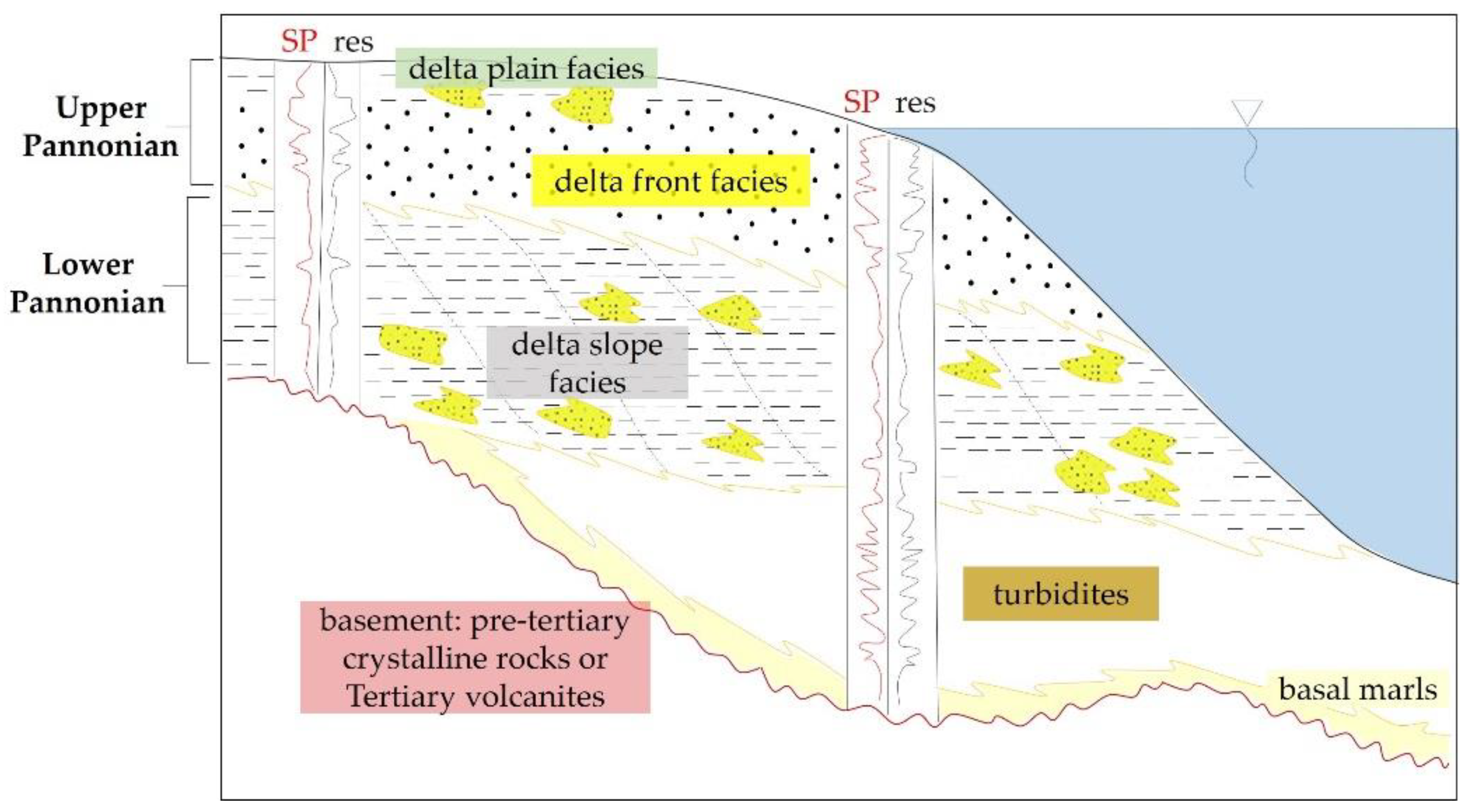

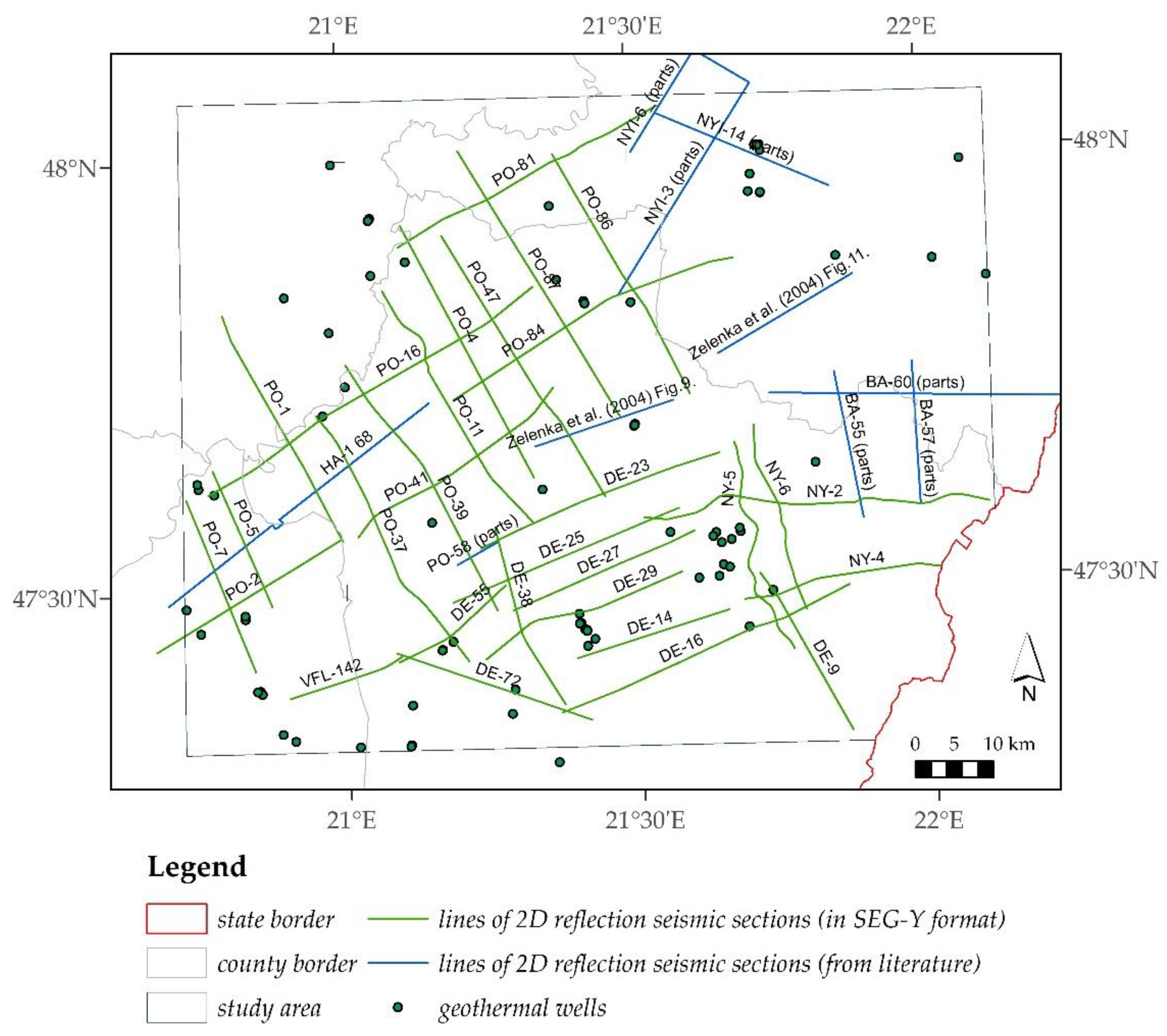

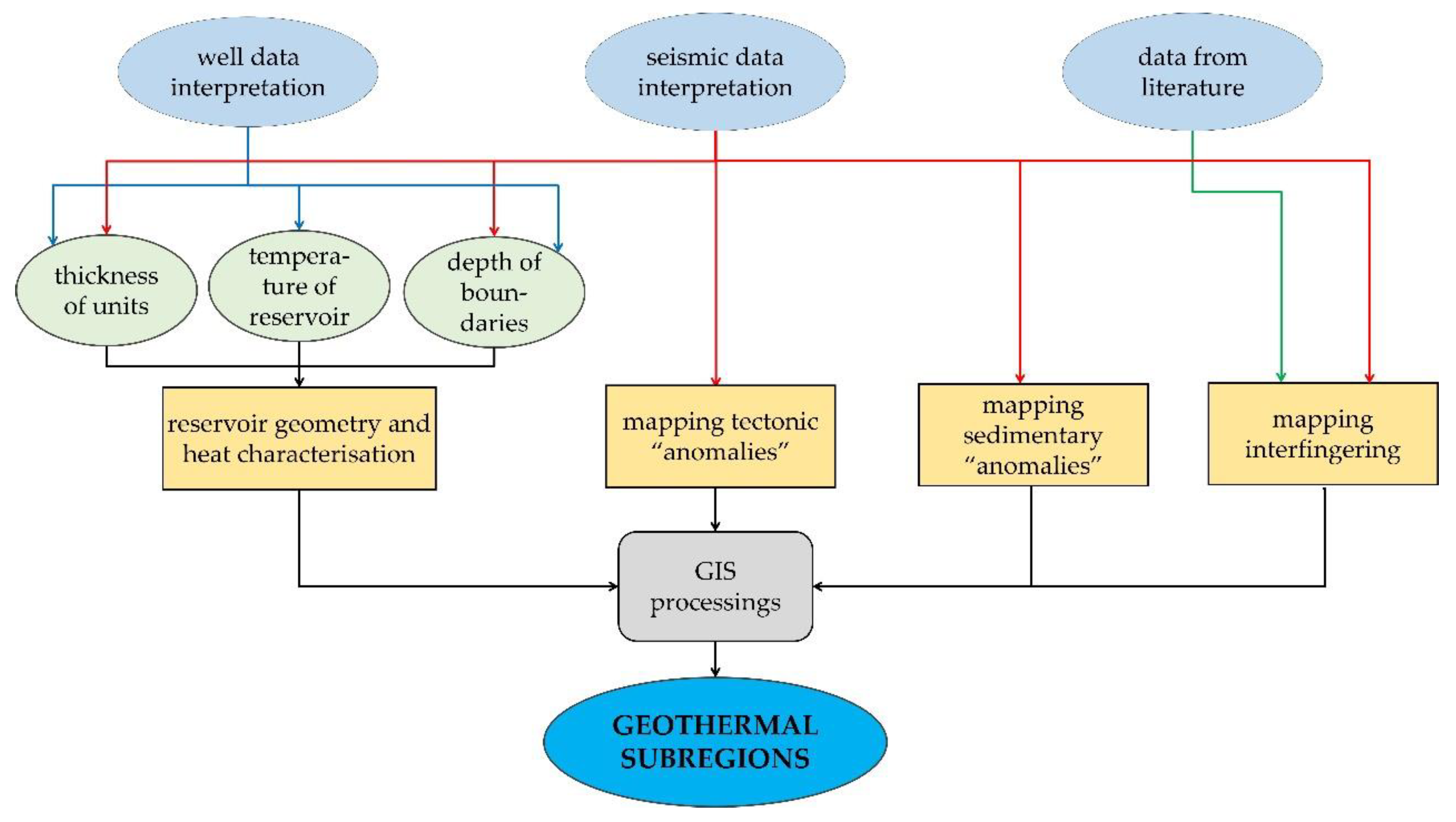

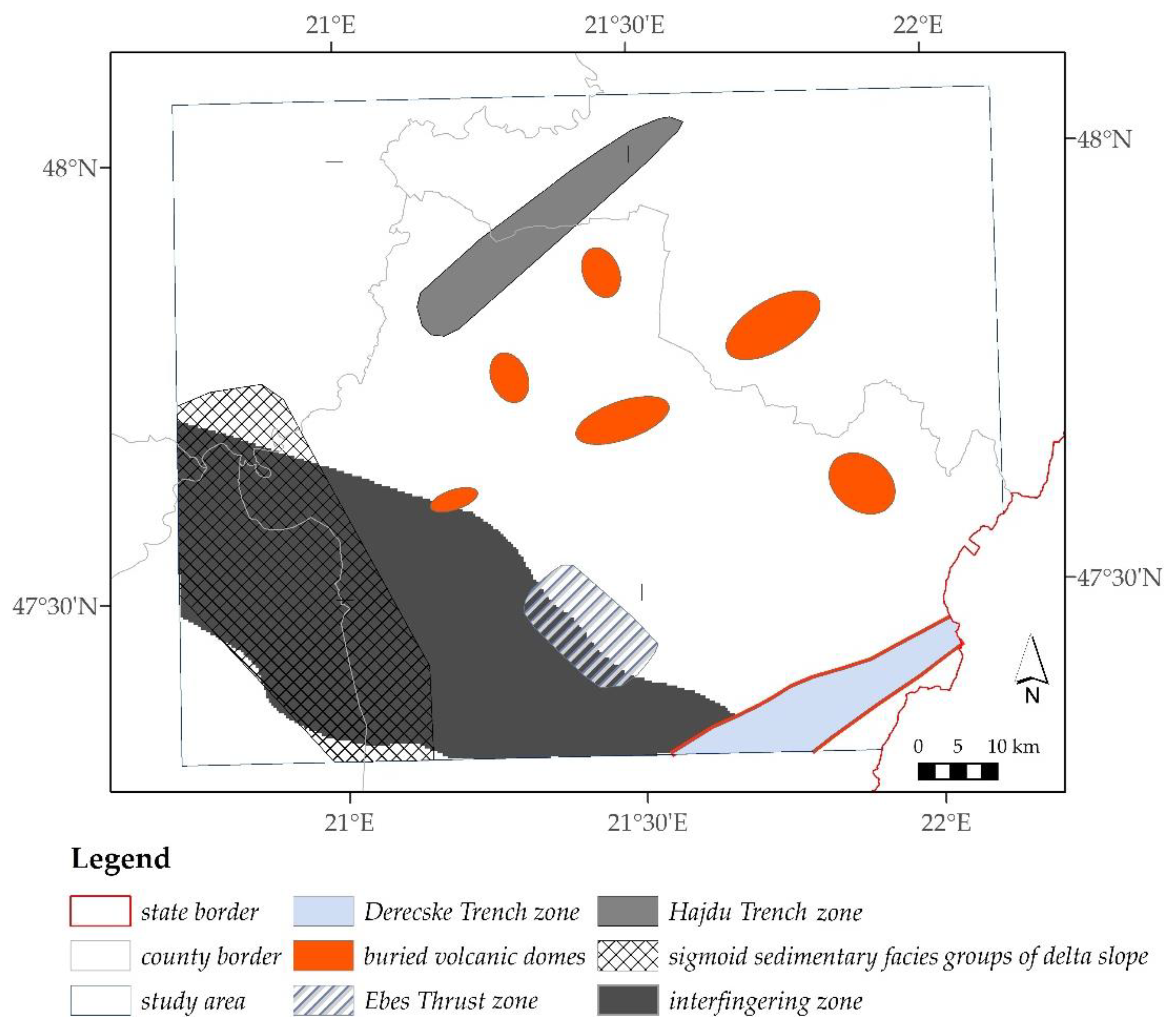

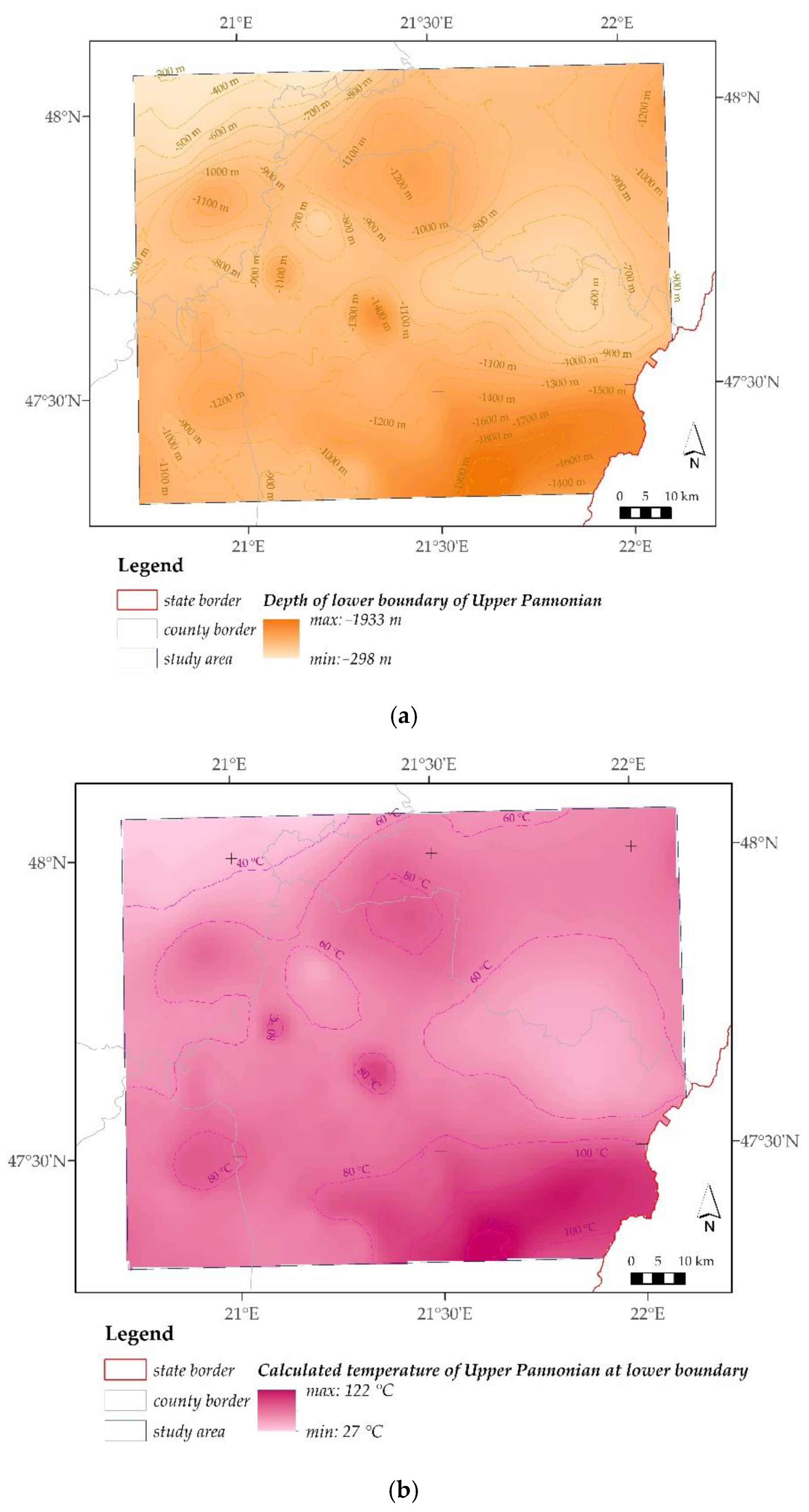
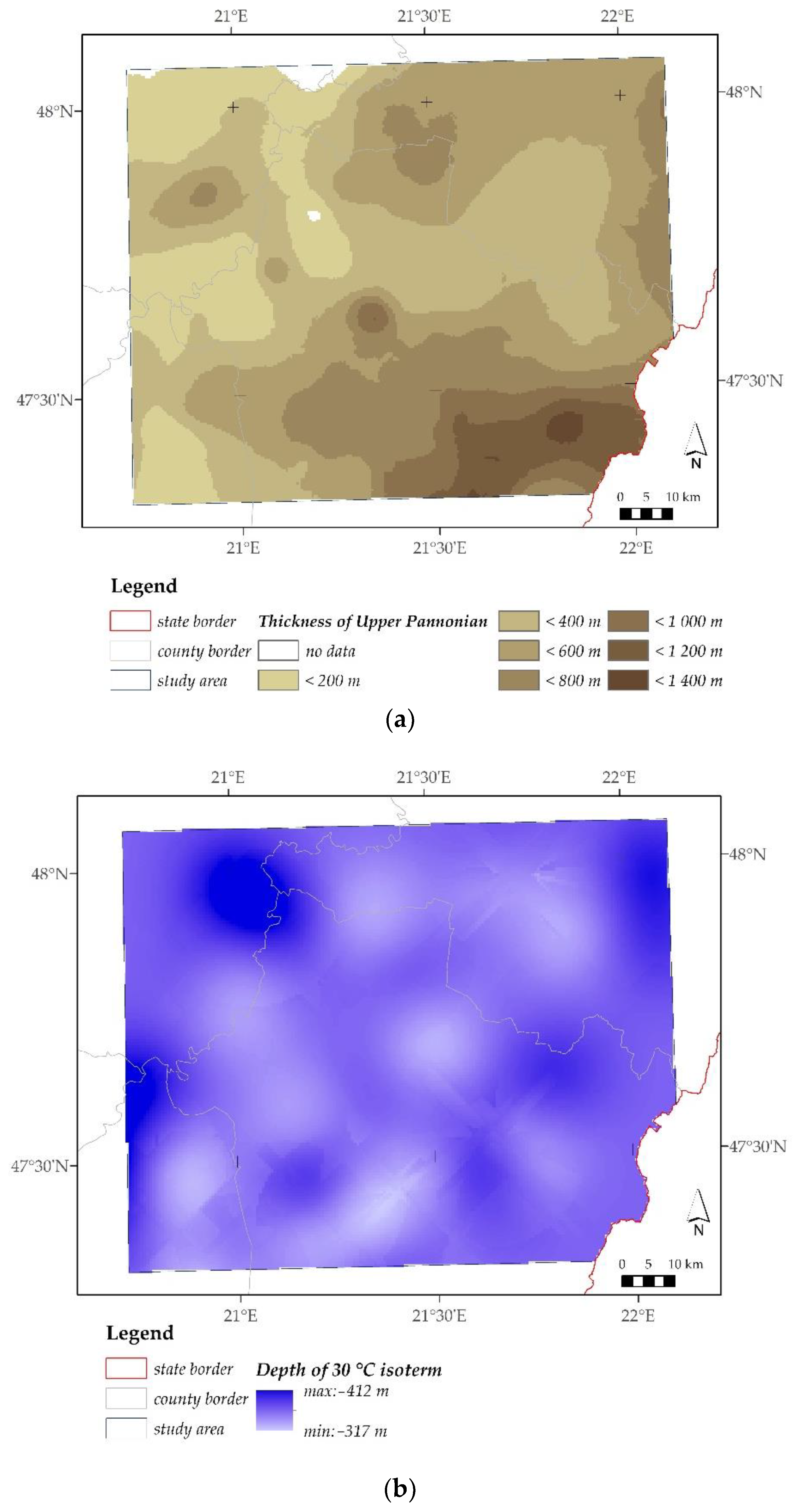
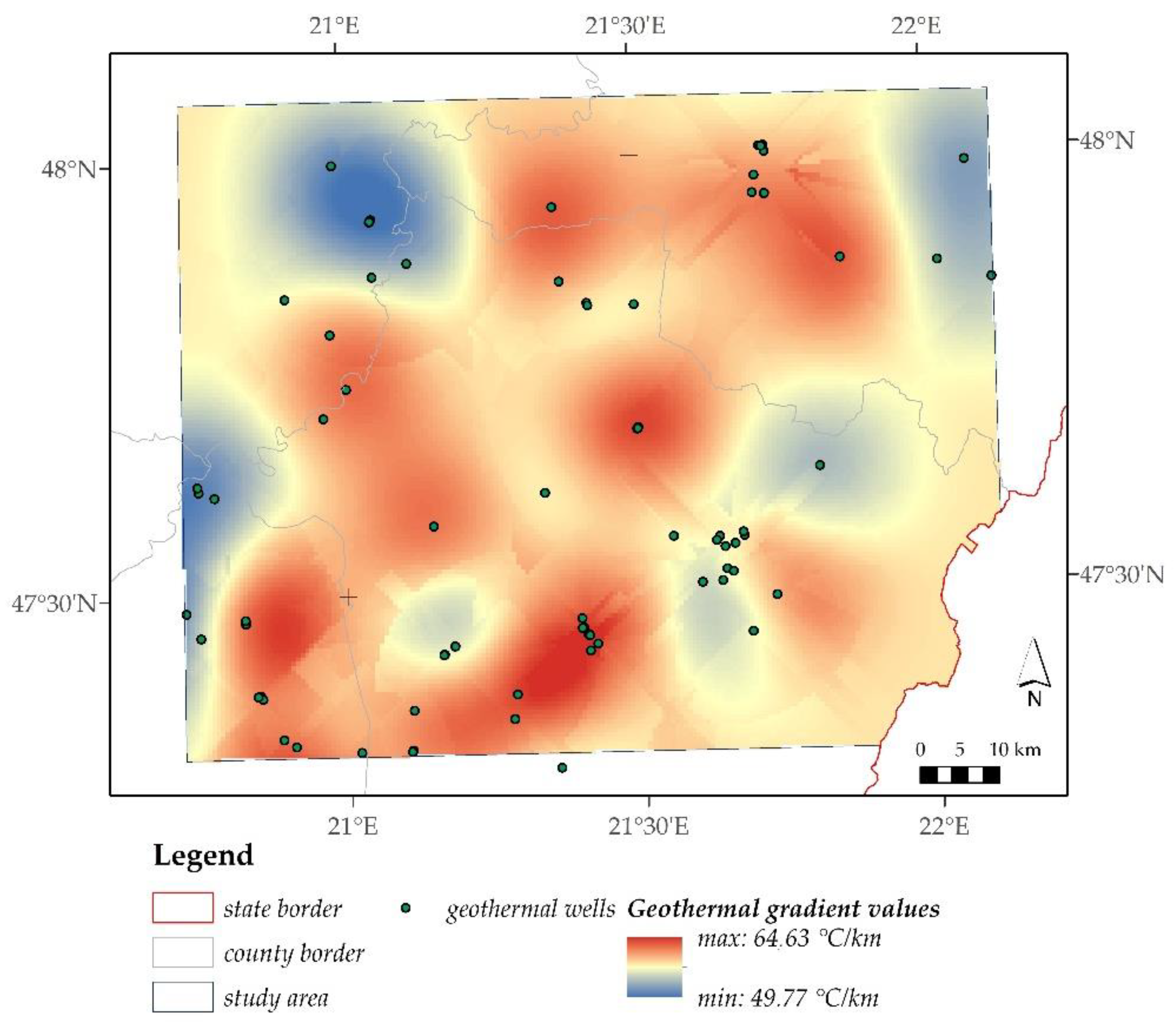
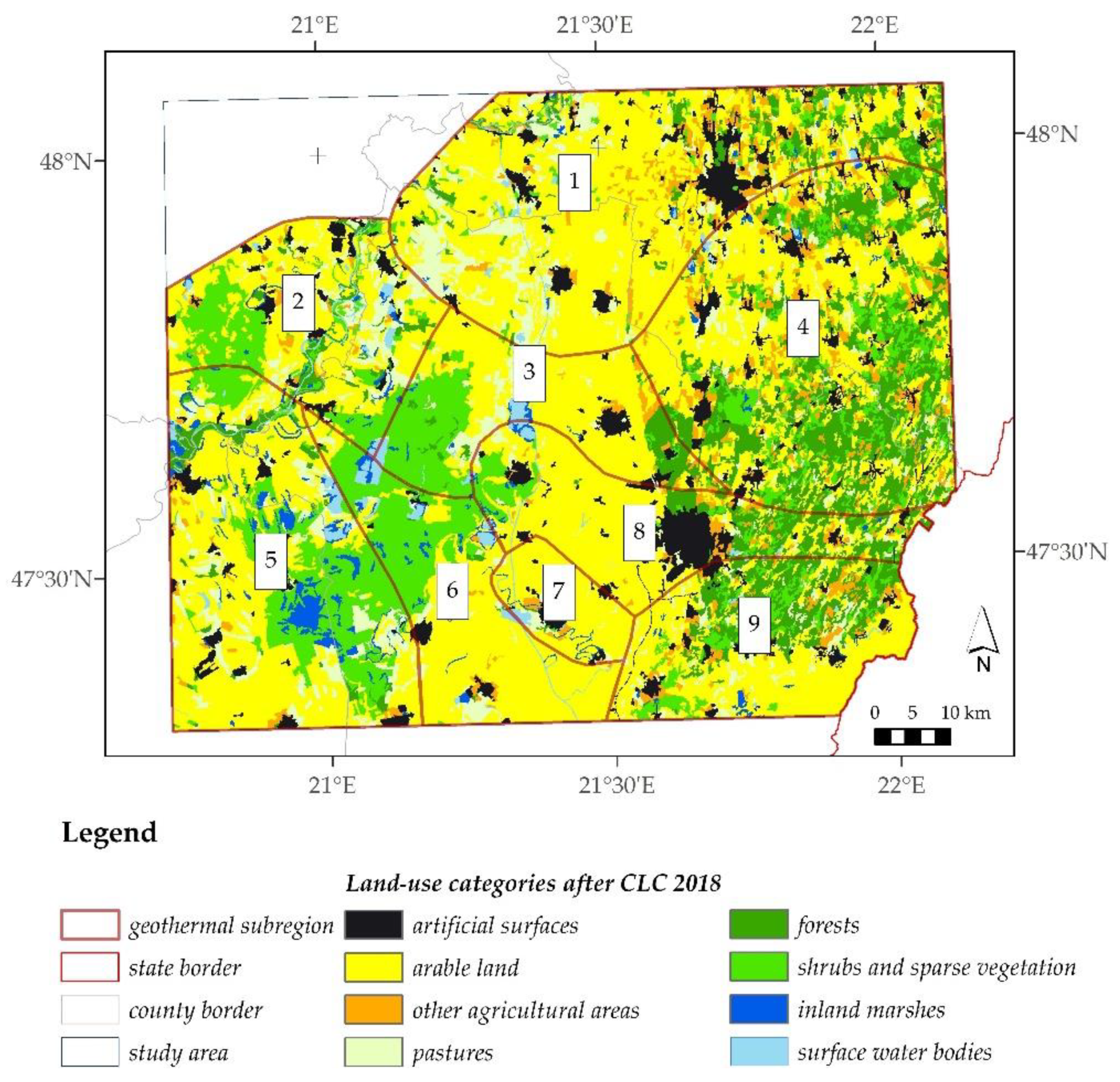
| Subregion | Max. Reservoir Temp. | Max. Reservoir Depth | Reservoir Thickness | Seismic Character |
|---|---|---|---|---|
| GSR1 | 55 °C to 85 °C | 790 m to 1280 m | 145 m to 670 m | Generally well mapped parallel reflections, fault structures and volcanic domes disturbed the geometry |
| GSR2 | 45 °C to 83 °C | 600 m to 1200 m | 0 m to 680 m | Tectonically not disturbed Pannonian sequences, uplifted basement, thinned out sediments |
| GSR3 | 46 °C to 70 °C | 600 m to 1000 m | 20 m to 620 m | Volcanic domes, medium-sized fault systems, parallel reflection units |
| GSR4 | 42 °C to 70 °C | 580 m to 1000 m | 220 m to 680 m | Folded pattern of reflection units and medium-sized fault systems, volcanic domes |
| GSR5 | 55 °C to 86 °C | 790 m to 1200 m | 70 m to 640 m | Large delta system with sigmoidal pattern, modified by faults and a large sub-marine canyon system |
| GSR6 | 66 °C to 105 °C | 880 m to 1600 m | 70 m to 890 m | Interfingering, parallel reflection units disturbed by medium-sized tectonic faults |
| GSR7 | 72 °C to 99 °C | 1000 m to 1490 m | 600 m to 930 m | Ebes Thrust zone, uplifted chrystalline basement, parallel reflection units |
| GSR8 | 59 °C to 97 °C | 850 m to 1500 m | 534 m to 1000 m | Minimal presence of tectonic faults and volcanic domes without significant effect on the reflection units |
| GSR9 | 84 °C to 122 °C | 1200 m to 1933 m | 780 m to 1390 m | First-order tectonic faults cause deepening of the basement and thickening of the Upper Pannonian sediment, divergent strata pattern |
| Category | GSR1 | GSR2 | GSR3 | GSR4 | GSR5 | GSR6 | GSR7 | GSR8 | GSR9 |
|---|---|---|---|---|---|---|---|---|---|
| Artificial surfaces | 8.0 | 6.2 | 3.8 | 6.5 | 3.6 | 2.3 | 8.8 | 13.8 | 5.9 |
| Arable lands | 61.2 | 48.0 | 50.7 | 41.3 | 49.1 | 59.2 | 75.6 | 53.8 | 47.9 |
| Pastures | 13.0 | 12.8 | 8.2 | 4.7 | 11.3 | 4.6 | 6.3 | 3.9 | 8.0 |
| Other agricultural areas | 6.3 | 2.7 | 2.8 | 9.0 | 1.3 | 1.2 | 3.1 | 4.3 | 6.5 |
| Forests | 6.7 | 5.1 | 7.4 | 26.7 | 3.7 | 0.7 | 0.8 | 13.3 | 21.0 |
| Shrubs and sparse vegetation | 3.2 | 20.4 | 23.8 | 11.1 | 22.7 | 25.5 | 0.1 | 8.2 | 9.6 |
| Inland marshes | 0.5 | 2.0 | 1.0 | 0.6 | 6.2 | 2.6 | 2.3 | 1.0 | 0.9 |
| Surface water bodies | 1.1 | 2.8 | 2.3 | 0.2 | 2.0 | 4.0 | 3.0 | 1.7 | 0.3 |
Publisher’s Note: MDPI stays neutral with regard to jurisdictional claims in published maps and institutional affiliations. |
© 2022 by the authors. Licensee MDPI, Basel, Switzerland. This article is an open access article distributed under the terms and conditions of the Creative Commons Attribution (CC BY) license (https://creativecommons.org/licenses/by/4.0/).
Share and Cite
Buday-Bódi, E.; Irfan, A.; McIntosh, R.W.; Fehér, Z.Z.; Csajbók, J.; Juhász, C.; Radócz, L.; Szilágyi, A.; Buday, T. Subregion-Scale Geothermal Delineation Based on Image Analysis Using Reflection Seismology and Well Data with an Outlook for Land Use. Sustainability 2022, 14, 3529. https://doi.org/10.3390/su14063529
Buday-Bódi E, Irfan A, McIntosh RW, Fehér ZZ, Csajbók J, Juhász C, Radócz L, Szilágyi A, Buday T. Subregion-Scale Geothermal Delineation Based on Image Analysis Using Reflection Seismology and Well Data with an Outlook for Land Use. Sustainability. 2022; 14(6):3529. https://doi.org/10.3390/su14063529
Chicago/Turabian StyleBuday-Bódi, Erika, Ali Irfan, Richard William McIntosh, Zsolt Zoltán Fehér, József Csajbók, Csaba Juhász, László Radócz, Arnold Szilágyi, and Tamás Buday. 2022. "Subregion-Scale Geothermal Delineation Based on Image Analysis Using Reflection Seismology and Well Data with an Outlook for Land Use" Sustainability 14, no. 6: 3529. https://doi.org/10.3390/su14063529
APA StyleBuday-Bódi, E., Irfan, A., McIntosh, R. W., Fehér, Z. Z., Csajbók, J., Juhász, C., Radócz, L., Szilágyi, A., & Buday, T. (2022). Subregion-Scale Geothermal Delineation Based on Image Analysis Using Reflection Seismology and Well Data with an Outlook for Land Use. Sustainability, 14(6), 3529. https://doi.org/10.3390/su14063529











